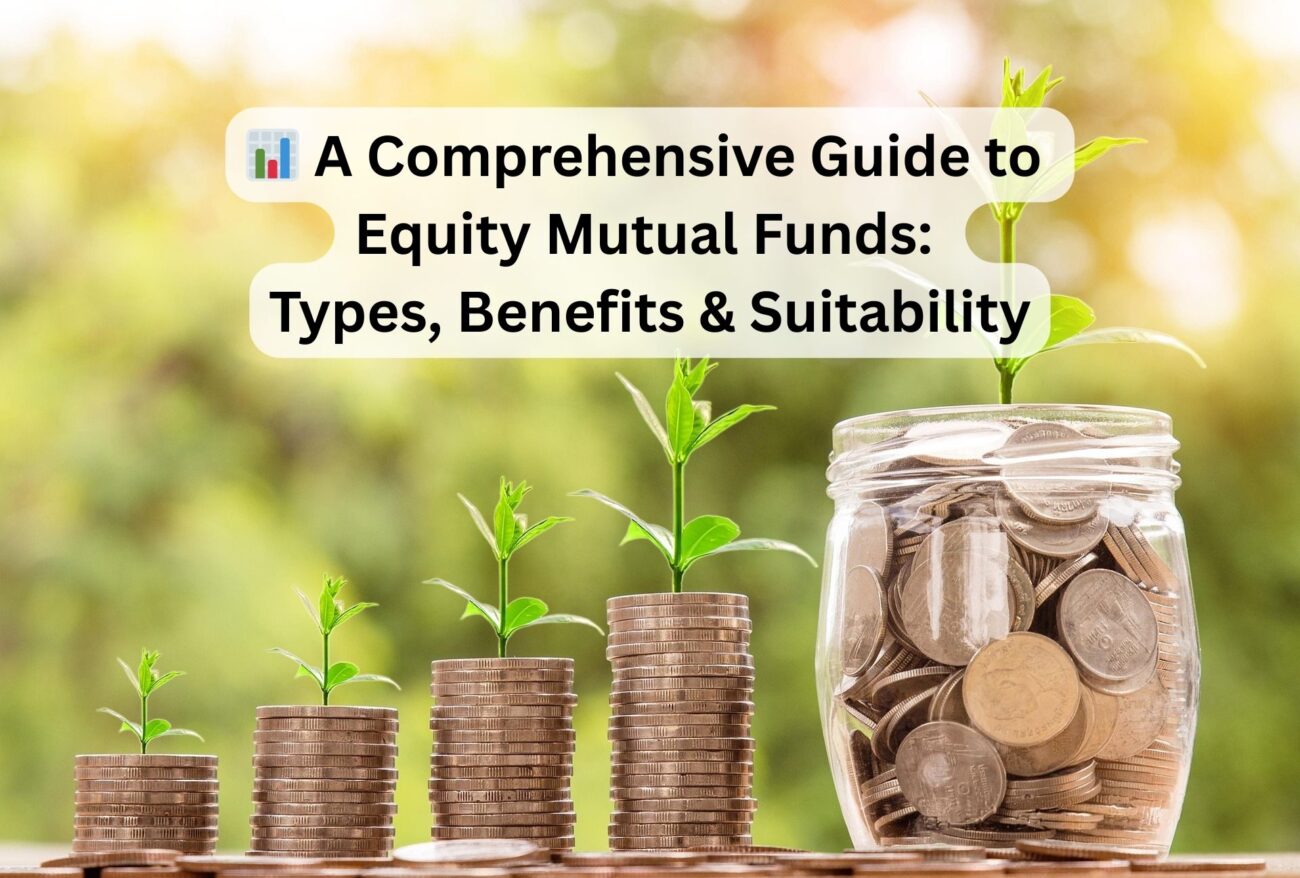When it comes to wealth creation in the long run, Equity Mutual Funds stand out as one of the most rewarding investment avenues. Designed for investors with a higher risk appetite and a longer investment horizon, these funds primarily invest in the equity shares of companies across different sectors and market capitalizations. The goal? Capital appreciation over time.
In this guide, we’ll take a deep dive into the world of equity mutual funds, breaking down their various sub-categories, exploring their features, risks, potential rewards, and which type of investor they’re best suited for.
🧩 What are Equity Mutual Funds?
Equity mutual funds are investment vehicles that pool money from multiple investors and invest it in the shares of listed companies. The performance of these funds is linked directly to the stock market, and hence, they tend to be more volatile compared to debt or hybrid funds.
Despite the risks, equity funds have historically provided better long-term returns, making them a preferred choice for investors seeking capital growth over 5–10 years or more.

🏢 Large Cap Funds: Stability with Steady Growth
Large Cap Funds invest in companies with large market capitalizations — typically those ranked among the top 100 by market cap. These are blue-chip companies with a proven track record, solid management, and established operations.
Key Features:
-
Lower volatility compared to mid and small caps.
-
Relatively predictable performance during market downturns.
-
Ideal for conservative equity investors.
Pros:
-
Stable returns
-
Better liquidity
-
Strong corporate governance
Cons:
-
Lower growth potential compared to mid/small caps
Best for: First-time investors or those seeking steady growth with lower risk.
🏭 Mid Cap Funds: Balanced Risk and Reward
Mid Cap Funds invest in medium-sized companies ranked between 101st and 250th in terms of market capitalization. These companies are in their growth phase and have the potential to become large caps in the future.
Key Features:
-
Higher growth potential than large caps
-
Moderate to high risk
-
More volatile than large caps
Pros:
-
Strong upside during bull markets
-
Good balance between risk and return
Cons:
-
Vulnerable during market corrections
-
Less researched and less liquid
Best for: Investors with moderate risk tolerance and a long-term investment horizon.
🏗️ Small Cap Funds: High Risk, High Reward
Small Cap Funds invest in companies ranked 251 and below by market capitalization. These firms are generally younger, innovative, and in their early growth stages.
Key Features:
-
High return potential
-
Significant volatility
-
Requires long investment commitment
Pros:
-
Can generate multi-bagger returns
-
More opportunities in niche markets
Cons:
-
High risk of capital erosion
-
Prone to market sentiment and liquidity issues
Best for: Seasoned investors with high-risk appetite and a horizon of 7+ years.
🔄 Multi Cap Funds: Diversified Equity Exposure
Multi Cap Funds invest across all market capitalizations — large, mid, and small. Fund managers have the flexibility to adjust allocations based on market conditions.
Key Features:
-
Diversification lowers overall risk
-
Dynamic allocation provides adaptability
Pros:
-
Balanced portfolio
-
Lower volatility than mid/small caps alone
Cons:
-
Dependent on fund manager’s skill
-
May underperform in trending markets
Best for: Investors looking for a one-stop equity solution with moderate risk.
🧠 Sectoral/Thematic Funds: Targeted Bets with High Potential
Sectoral Funds invest in a single sector (e.g., banking, IT, pharma), while Thematic Funds follow broader investment themes like ESG, rural consumption, or innovation.
Key Features:
-
Highly focused investments
-
Extremely volatile
Pros:
-
Potential for high returns in booming sectors
-
Opportunities to capitalize on macro trends
Cons:
-
High concentration risk
-
Poor diversification
Best for: Experienced investors who understand market cycles and sector-specific risks.
💸 ELSS (Equity Linked Savings Scheme): Tax Savings + Growth
ELSS funds are equity mutual funds that come with a three-year lock-in period and offer tax benefits under Section 80C of the Income Tax Act.
Key Features:
-
3-year lock-in (shortest among tax-saving instruments)
-
Up to ₹1.5 lakh deduction under Section 80C
-
Equity-oriented portfolio
Pros:
-
Dual benefit of tax saving and wealth creation
-
Ideal for salaried individuals
Cons:
-
No liquidity for 3 years
-
Market-linked returns
Best for: Tax-saving investors with moderate to high risk appetite.
🎯 Focused Funds: High Conviction, High Risk
Focused Funds invest in a limited number of stocks (up to 30). These are high-conviction bets by fund managers who believe in the long-term potential of selected companies.
Key Features:
-
Concentrated portfolio
-
Aggressive investment style
Pros:
-
Potential for higher returns
-
Easier to track and analyze
Cons:
-
Lack of diversification increases risk
-
Performance tied to a few companies
Best for: Informed investors who believe in the fund manager’s conviction and are okay with concentration risk.
🧾 Final Thoughts: Which Equity Fund Is Right for You?

The choice of equity mutual fund depends on your risk appetite, investment horizon, and financial goals. Large cap funds are ideal for beginners, while small and sectoral funds are better suited for experienced investors. ELSS gives you tax benefits, and multi-cap or focused funds offer flexible strategies.
Before investing, always evaluate:
-
Your long-term financial objectives
-
Your ability to withstand short-term volatility
-
The consistency and strategy of the fund manager
Diversification across multiple sub-categories can also help in reducing portfolio risk while improving returns.
❓ 10 Frequently Asked Questions

-
What is the minimum investment in equity mutual funds?
Most mutual funds allow SIPs starting as low as ₹500 per month. -
Is it safe to invest in equity mutual funds?
They carry market risk but are safer over the long term if invested wisely. -
Can I lose money in equity mutual funds?
Yes, there’s a risk of loss, especially in the short term due to market volatility. -
How are equity mutual funds taxed?
Long-term gains (above ₹1 lakh) are taxed at 10%, and short-term gains at 15%. -
Which equity fund is best for beginners?
Large cap or ELSS funds are ideal for first-time investors. -
How long should I invest in equity mutual funds?
At least 5–7 years for meaningful returns and to ride out market cycles. -
What is an ELSS fund?
It’s a tax-saving equity fund with a 3-year lock-in under Section 80C. -
What is the difference between large, mid, and small cap funds?
The main difference lies in the size of companies they invest in, which affects risk and return. -
What are sectoral funds?
Funds that invest in a specific sector like pharma, IT, or banking. -
Should I invest lump sum or via SIP?
SIPs help in rupee-cost averaging and are generally recommended for equity funds.
📢 Full Disclaimer:
Investing in mutual funds is subject to market risks. Please read all scheme-related documents carefully before investing. The past performance of mutual funds is not indicative of future returns. Always consult with a certified financial advisor before making any investment decisions. This article is for educational purposes only and should not be construed as investment advice.


2 thoughts on “📊 A Comprehensive Guide to Equity Mutual Funds: Types, Benefits & Suitability”